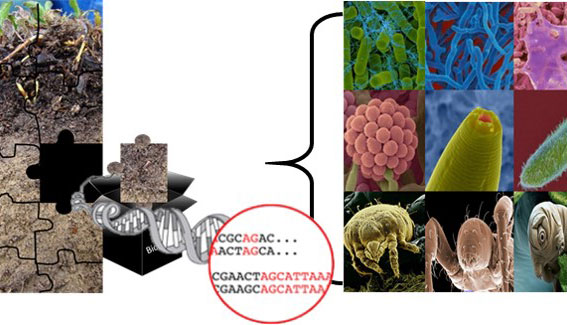The biodiversity of the microscopic world around us is almost beyond imagination: a single gram of soil or 100 mL of river water can contain several million microorganisms, complex microbial communities that play a fundamental role in the health of the ecosystems we rely on for everything from drinking water to agricultural productivity.
With funding from the Government of Canada's Genomics Research and Development Initiative (GRDI), researchers across the federal government are collaborating on the Ecobiomics Project to take advantage of new genomics technologies to better understand how these microbial communities function.
At the Agriculture and Agri‑Food Canada (AAFC) research station at Harrow in southwestern Ontario, for example, soil microbial ecologist Dr. Lori Phillips is looking at how different agricultural practices can affect microbial communities and, in turn, how that can impact on the health of the soil and nearby watercourses.
Small but mighty
"The microbes in the soil are responsible for a number of essential processes—some, for example, turn fertilizer into a form that plants can actually use," says Dr. Phillips. "So, among the questions we're trying to answer is whether we can manage the abundance and activity of those microbes—because if they don't make the fertilizer available to the plants at the right time, those nutrients may run off into a drainage ditch, then into a creek and finally into a river or lake, and contribute to the growth of algae and other serious environmental problems.
"On the other hand, these and other microbes make nutrients like phosphorus and nitrogen more mobile, and therefore more likely to leach out of the soil," says Dr. Phillips, "So we're also looking at how our agricultural practices can discourage the growth of those microbes at different times of the year."
Monitoring microbial movements
The research team led by Dr. Phillips at AAFC is collaborating with a team at Environment and Climate Change Canada (ECCC) to study the flow of nutrients from farms to waterways—and to see which microbes are also making the trip.
Harmful algal blooms, for example, are caused by cyanobacteria, which are very common. Working with the AAFC team, ECCC Research Scientist Dr. Sophie Crevecoeur and her team at the Canada Centre for Inland Water in Burlington, Ontario are using DNA analysis to determine whether the cyanobacteria in the soil near waterways are related to the cyanobacteria blooming in nearby lakes and rivers.
"By looking at samples taken from riverbeds, we can see how the cyanobacterial community may change as it travels downstream, and how other microorganisms may be involved in those changes," explains Dr. Crevecoeur, "Including whether members of the microbial community are processing nutrients into a form that the cyanobacteria can use to grow and bloom."
Opening "the black box"
Dr. Tom Edge, who initially co‑led the Ecobiomics Project at ECCC, says genomics technologies have revolutionized the study of microbial communities in water and soil.
"Until fairly recently, you were limited to what you could see through a microscope and what you could grow in culture in the lab—these microbial communities really were a black box," says Dr. Edge, now an adjunct professor of biology at McMaster University in Hamilton. "Now—and GRDI investment has played a big part in this for the Government of Canada—we have technologies that let us see the DNA of everything that's in there, enabling us to really figure out which microorganisms are responsible for what processes, the conditions under which different species thrive, and which ones are predictors of harmful environmental changes."
Collaboration across government…
The research Drs. Phillips and Crevecoeur are working on is one of 16 complementary research efforts that make up the GRDI Ecobiomics Project. This 5‑year project involves dozens of scientists at 7 federal departments and agencies sharing knowledge and resources to advance our understanding of the enormous diversity of microorganisms and invertebrates that are crucial to the health of terrestrial and freshwater ecosystems.
…and across borders
Since meeting at an international conference, Dr. Phillips and Dr. Veronica Acosta‑Martinez, a soil scientist with the U.S. Department of Agriculture (USDA) in Lubbock, Texas, have been contributing to one another's research—including a summer 2019 visit to Harrow by USDA post‑doctoral researcher Dr. Lumarie Perez‑Guzman, to learn molecular biology techniques that Dr. Phillips has developed under the GRDI program.
"We're both interested in soil microbial communities and the soil as a living ecosystem, but we're working with different types of soils, different resources and different testing methods, so it's an opportunity to share findings and broaden our knowledge base," says Dr. Acosta‑Martinez. "Among other things, we're able to see how microbial communities function in a wider range of soils and conditions, and we're also using our relationship to validate each other's testing protocols."
Practical knowledge

Dr. Phillips says that while the science sounds complicated, the goals of the research are simple: "We are building knowledge that will contribute to the long‑term productivity and environmental sustainability of our agricultural industry," says Dr. Phillips. "We're already making some important discoveries—such as which microorganisms are promoted by different crops, so we can better define the impacts of specific crop rotations."
Metagenomics tools are enabling federal scientists to see inside the "black box"—the complex microbial communities in soil and water that play a fundamental role in the health of the ecosystems we rely on for everything from drinking water to agricultural productivity.